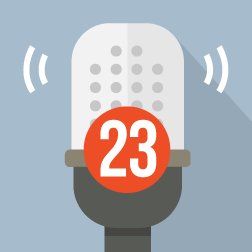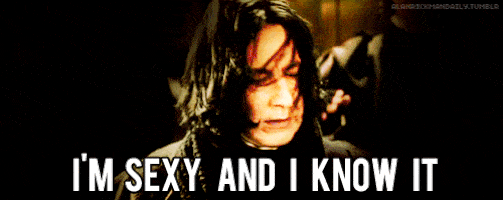Full disclosure: This episode is full of Harry Potter references and talk about ego.
I’ve spoken a lot about how emotion plays into content, both in this podcast and generally in my writing. But there’s another way to think about your approach to creating successful content, and that’s by creating ego-bait.
Think of it this way:
People want to see themselves in the content — or they want the content to help them see themselves.
Listen in to hear my explanation of both concepts and how you can apply the insight to your content development.
In this episode, you’ll learn:
- Examples of both types of ego-bait
- Questions you need to ask yourself when executing content
- Why it’s important to craft a promotional strategy that matches your content
Hope you enjoy!
This podcast seeks to answer your questions about content marketing and digital PR with straightforward, actionable tips. You can find all episodes here.
I’ll be publishing biweekly, so subscribe to stay up-to-date!
Have a question you want to submit to the podcast?
Email me at [email protected] or comment below!
Have any additional insight on building content that caters to the ego? Post it in the comments! I’d love to hear your thoughts.
Full Transcript:
Welcome to Ask Amanda About Marketing, a podcast in which I, Amanda, or occasionally a special guest, answer your questions about inbound marketing. Straightforward, right? If you want to submit a question, email me at [email protected]. I’d love to hear from you. Let’s get right to it.
Hey, Ask Amanda listeners! It’s been a while. I apologize for pushing this episode back a week. Last week, I was kind of on the verge of catching a cold and my voice was not in top shape. It might have had something to do with the fact that I had just gotten back from visiting Munich for Oktoberfest, but I’ll leave it at that. Anyway, I’m really glad to be back and doing the show and we’ll continue doing it every two weeks from today.
And if you’re wondering, “How do I find out about these types of things when it’s just going to miss an episode?” I post updates on my Twitter account. So feel free to follow me at @millanda and I post anything about the podcast there. I also realized that my tweets tend to be 50% marketing-related and 50% food-related. So just a warning there.
To get right to it in this week’s episode, I’m going to talk about the ego and that doesn’t just mean the Kanye West type of ego. I mean your identity, what everybody has in terms of wanting to better understand themselves. I think that this concept plays a crucial role in all content and I see being divided in two ways: either people want to see themselves in the content or they want the content to help them see themselves.
I want to break this episode down into two parts based on both of those philosophies. And I think that if you’re able to incorporate at least one of the other in your content, it’s much more likely to really resonate and to be something that people want to actively share. In general, from my experience, I’ve seen that people are constantly trying to define themselves, understand themselves, and then share that identity, that portrayal, of who they are with the people they know. We constantly want to be putting that out there and showing the world—this is who I am, this is who I think I am, and this is who I want to be. So if you’re generating content, you can think of it in either one of those two ways.
Let’s start with people seeing themselves in the content. That might seem a little tough if you’re working at a niche industry. Let’s say you sell lamps. You’re not always going to know how to create content that’s extremely emotionally compelling and that’s going to really captivate people.
However, in that case you’re thinking, how can you answer questions people have, provide stories and scenarios in which people have faced, and that way if you’re creating content and they’re reading it and they’re saying—I’ve been there I’ve experienced that that means they’re seeing themselves in your content and likely to keep reading.
So for example, if you sell specialty lamps that are really nice and your content is about how people really want to enhance the look of their homes, but they don’t have enough money to afford really fancy lighting. You can pose a whole scenario in which your product is the answer to that. But again, it’s all about having people really see themselves in the story you’re telling.
If you’re working with more general topics, the easiest way to do this is to take your data and segment it by demographic because sometimes if we’re just talking about people—like I’m doing now—it’s probably better for me to say “marketers” because if it’s not clear you will already relate more to the word “marketers” than you do to just general “people.”
So, if you had a bunch of data, say, about driving behaviors, you’re going to be kind of interested to know how people in the United States drive, but you’re going to be more interested to know how people in your hometown drive or people in the city you currently live in or people in that state and how it compares to other cities and other states.
This method of “Geo-bait” is highly effective. Some of our very best content has been Geo-bait and it’s been because people love to see how their cities and states and countries stack up against others. That’s the reason for it. It’s because they feel an allegiance to where they are and where they’re from. And again, that makes them think, oh this is relevant to me in some way. It’s not just general information about people overall. It’s about people from a certain area.
So Geo-bait is one really great way to do it, but other demographics count, too. If you want to break things down by gender, by age, by ethnicity, by race, by whatever—any demographic that makes sense with the content you’re producing. The goal is to speak to particular audiences. You don’t always want to get too narrow because then you’re limiting the audience you can reach.
But—especially if you have a certain intent in mind with your content—think about that target audience, who they are. Hopefully, you have a buyer persona or something like that already drafted that you can pull from and then consider who those people are and how you can target them with your content. The more you can relate to them, the better your content will perform.
So when you’re creating content like this, if you’re trying to help people see themselves in which you produced, remember three things: make sure that the content answers the question—What does this have to do with me? How is this relevant to me? You want to make sure that they’re not really confused about that point.
Number two is, take broader topics and segment them down for additional insights. Like I said, you’re going to relate to people more when it’s more localized but you’re also going to learn more and there’s nothing harmful about adding more data if it’s relevant.
Third, it’s extremely important that when you produce content like this that you’re publishing it where those types of audiences are going to be reading it. If you’re that lamp company and you’re hoping that people who are looking to buy lamps or going to be reading your content. You shouldn’t just be posting it on a generic site. You need to be posting it on a home improvement site or a home decor site or somewhere where people are feeling like they haven’t completed their homes and they want to make those improvements and it’s going to make sense for them to read it there and they’re going to see themselves in that content.
So not only do you need to think about how to create it appropriately you need to think about how to disseminate it appropriately. Another example of this is that Geo-bait concept. You’ll find that even if you’re able to get a general publisher to write a story about your content, sometimes—we’ve seen this a lot with our campaigns—you’ll see natural syndication to local publishers.
If your content breaks things down by region or by city or by state, those areas are going to be way more interested in featuring where they’re based and they’ll make that the headline. So it’s a great example of how stories could have multiple angles and multiple levels of importance to different people. If you highlight that, then you’re signaling to those writers that they can do the same. They can pull what’s the most interesting to them and make that their story.
The second type is content that helps people see themselves. As corny as that sounds, it’s really so important. I think there’s a subtle back-of-the-mind mission going on constantly of people trying to figure out who they are, outside of the typical quarter-life midlife, whatever crisis people are going through, whatever existential thing they’re dealing with.
No matter what, we’re always looking for ways to define ourselves. I think one of the best most fun and common examples of this are quizzes that you can take online. For example, Myers-Briggs is actually the perfect candidate to explain this because we’re always trying to see—okay, not only do we want to know how we relate to others. We’re trying to learn more about ourselves. What did those four letters tell us?
You know, do I make decisions based on my logic or my feelings, or what-have-you? Sometimes we don’t know these things without a deeper analysis of ourselves, asking ourselves certain kinds of questions. So content that does that—that prompts that further investigation, that raises those questions, that makes us curious—is always really compelling. I’ve always been fascinated by how this kind of resurrects itself and a lot of very pop culture kind of ways.
For example, the Harry Potter houses. Most Harry Potter fans I know know what house they belong to and feel some sort of allegiance for that house. For example, I’m a Slytherin I own a Slytherin scarf from The Wizarding World of Harry Potter in Orlando, Florida—don’t judge me. They take it really seriously, you know to the extent you can take a fictional thing seriously.
But you see this in other things, too. You see this in things like zodiac signs, how people will use their birthday and their corresponding zodiac sign to better understand themselves, to kind of make sense of personality traits, to predict what’s going to happen to them that month or that year—they love having that additional insight into who they might be and what might happen to them as a result.
Once you really start thinking about it, you see this pop up in so many different ways and if you’re thinking oh my God, this is getting really nerdy talking about Harry Potter and zodiac and whatever, what about sports? Anybody who is a sports fan doesn’t just casually watch their team. They feel like they’re part of that team.
They feel that they can—it’s part of their identity. They wear the logo. They wear the shirts, the jerseys, the hats. They hang out with people who like the same team. It is part of how you define yourself. And if you’re able to do this in your content—if you’re able to help people either draw those conclusions or learn more about themselves—they will consume it and they’ll want their friends to do it too because that comparison component makes it all the more interesting.
Okay, you know who you are, but how do you compare to the general public? How do you compare to your friends? Who are they?
So when you’re creating content like this, a couple of things you need to keep in mind. First make sure that your content answers the question: What does this say about me? Help people learn something about themselves.
And if you’re not trying to make a quiz and you’re thinking how do I create content like this, then the second thing you might want to think about is—identify cultural or social questions, greater questions that people have that they’re wondering about and provide new insights about those. A lot of the time, if you look at what’s trending, a lot of articles try to dissect those trends. Why do people behave this way? Why are people acting in this way?
And then if people say that there are they see that headline and they say, oh I do act that way. I do behave that way. They’re going to want to read it because they’re going to want to know what an expert has to say on the topic.
For example, if you see an article that says this is why Slytherins are ambitious, to use Harry Potter as an example again. Because I am a Harry Potter fan. I would click on that. I’d be curious. Okay, I already kind of identify as Slytherin. So what does make me that way or what else am I if I’m ambitious? What else am I? What are my other qualities?
So it doesn’t have to be explicitly, here’s a survey or here’s a quiz, let’s find out a little bit more about yourself. But when you’re coming up with the thesis of your content, think about how you’re going to help people learn about themselves. What are they going to be able to discern about why they do what they do or think what they think?
And again, this could be as broad as delving into the psychology behind major cultural shifts, but it could be more specific as well.
So to summarize, don’t leave ego out of content. The easiest way to do this is when you’re writing or creating a graphic or whatever it is you’re working on, remember that you’re writing it for somebody. To somebody. Always keep that audience in mind. Create that buyer persona that I mentioned earlier.
If you’re not directly trying to reach potential customers, still imagine who it is you’re trying to talk to, who’s going to be interested in this content you’re creating and why are they interested in it. And it’s then that you’re going to be able to tap into that element of identity and who we are and what this content says about who we are.
If you’re interested in more examples, feel free to shoot me an email or tweet. Again. My email is [email protected] and my Twitter handle is @millanda. Of course, you can also reach out to me at either of those places to submit a question for the podcast. I will be switching back to having a guest on the show in two weeks. So I’m very much looking forward to that and I hope you all enjoy the rest of your day.
Thanks again for listening. If you enjoyed this episode, click subscribe, don’t leave me with the realization that I’m talking to no one and please rate and review on iTunes so I can keep making this podcast better and your lives easier. Take care.









